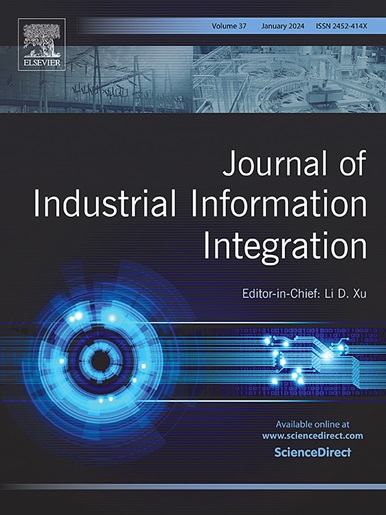Multi-objective heterogeneous interactive human-robot collaborative disassembly line balancing with partial destructive mode in type-2 fuzzy environment
IF 10.4
1区 计算机科学
Q1 COMPUTER SCIENCE, INTERDISCIPLINARY APPLICATIONS
引用次数: 0
Abstract
Interactive human-robot collaborative disassembly lines represent a prominent application of the Industry 5.0 paradigm, brought to life by the synergy of industrial information integration and advanced automation. This advanced production model enhances recycling efficiency for End-of- Life products by integrating the complementary strengths of humans and robots, enabling their cooperative or parallel execution of disassembly tasks. However, balancing such lines remains challenging. Existing research has limited consideration of the uncertainties in the disassembly process and the heterogeneity of operators, typically adopting non-destructive disassembly modes that are not always feasible in practice, thereby limiting their applicability. Therefore, this study proposes a fuzzy partial destructive heterogeneous interactive human-robot collaborative disassembly line balancing problem. The problem supports flexible configurations of diverse operators, employs interval type-2 triangular fuzzy sets to represent uncertainties during disassembly more precisely, and introduces a partial destructive disassembly mode. It aims to minimise the number of active workstations, differences in operator idle time, and disassembly energy consumption. Given the NP-hard nature of this problem, a multi-objective discrete bees algorithm is developed. This algorithm adopts a two-parameter bees algorithm search framework, incorporating four scout bee initialisation rules, five neighbourhood search operators, an adaptive operator selection strategy, and two enhanced search operators. The proposed model and algorithm are applied to two disassembly scenarios involving a retired power battery and a transmission. Further comparative analysis shows that the proposed method improves disassembly performance. To further understand the behaviour and performance of the model, we also conduct comprehensive sensitivity analyses. Finally, comparative experiments are performed against the GUROBI solver and five other advanced algorithms, validating that the proposed algorithm exhibits superior performance.
2型模糊环境下具有部分破坏模式的多目标异构人机协作装配线平衡
人机交互协作装配线是工业5.0范式的突出应用,是工业信息集成和先进自动化的协同作用。这种先进的生产模式通过整合人和机器人的互补优势,使他们能够合作或并行执行拆卸任务,提高了报废产品的回收效率。然而,平衡这些路线仍然具有挑战性。现有研究对拆卸过程的不确定性和操作人员的异质性考虑较少,多采用非破坏性拆卸模式,但在实际操作中并不总是可行的,从而限制了其适用性。因此,本研究提出一个模糊部分破坏性异构交互人机协同拆解线平衡问题。该问题支持多种算子的灵活配置,采用区间2型三角模糊集更精确地表示拆卸过程中的不确定性,并引入部分破坏性拆卸模式。它旨在最大限度地减少活动工作站的数量,操作员空闲时间的差异,以及拆卸能耗。考虑到该问题的NP-hard性质,提出了一种多目标离散蜜蜂算法。该算法采用双参数蜜蜂算法搜索框架,包含4个侦察蜜蜂初始化规则、5个邻域搜索算子、1个自适应算子选择策略和2个增强搜索算子。将该模型和算法应用于涉及退役动力电池和变速器的两种拆卸场景。进一步的对比分析表明,该方法提高了拆卸性能。为了进一步了解模型的行为和性能,我们还进行了全面的敏感性分析。最后,与GUROBI求解器和其他五种先进算法进行了对比实验,验证了该算法具有较好的性能。
本文章由计算机程序翻译,如有差异,请以英文原文为准。
求助全文
约1分钟内获得全文
求助全文
来源期刊

Journal of Industrial Information Integration
Decision Sciences-Information Systems and Management
CiteScore
22.30
自引率
13.40%
发文量
100
期刊介绍:
The Journal of Industrial Information Integration focuses on the industry's transition towards industrial integration and informatization, covering not only hardware and software but also information integration. It serves as a platform for promoting advances in industrial information integration, addressing challenges, issues, and solutions in an interdisciplinary forum for researchers, practitioners, and policy makers.
The Journal of Industrial Information Integration welcomes papers on foundational, technical, and practical aspects of industrial information integration, emphasizing the complex and cross-disciplinary topics that arise in industrial integration. Techniques from mathematical science, computer science, computer engineering, electrical and electronic engineering, manufacturing engineering, and engineering management are crucial in this context.
 求助内容:
求助内容: 应助结果提醒方式:
应助结果提醒方式:


